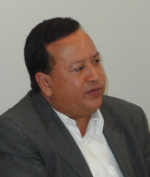In depth
The indigenous peoples of Colombia and the peace process

Weildler Guerra Curvelo
This scene takes place at the heart of the Sierra Nevada de Santa Marta, Colombia. An elderly indigenous woman, Ana Teresa Alberto, looks at the diminished flow of an ancient river and thinks back nostalgically to her youth, when a woman could not cross the waters alone; now a six year old child can cross them unaided. "More violence means less water" she concludes with resignation.
In the territory of Colombia there is an indigenous population of 1.37 million people, which represents just over 3% of the country's total population, estimated at 46 million. They include very distinct groups, which have very different ways of making a living. They include horticulturalists; people who live from hunting, fishing and gathering; pastoralists; farmers; artisans and merchants. Many of them are distributed in peripheral areas, far from the centre of the country. They live in the Amazonian rainforests, in the rugged mountains of the Andes, on the interfluvial plains, on the coastal areas of the Pacific and the semidesert territories on the shores of the Caribbean. For more than half a century, they have seen armed groups of different ideologies marching across their lands. These pass through decade after decade, like so many Roman cohorts, leaving pain and devastation in their wake. It is an endless violence that, far from representing the birth pains for the emergence of a new and fairer political and economic order, is more like an excruciatingly painful, chronic, incurable disease with no useful social role.
Years of the colonisation of their land, of the clearing of their forests to plant illegal crops, of legal and illegal mining, of the expansion of monocultures like palm oil and of the construction of dams for power generation have led to different forms of violence that go not only against human beings but also against the very landscape. For this reason, and also because as social beings they have their own symbolic vision concerning the physical environment, and a point of view different from Western ideas of 'development', most members of the Amerindian peoples make a direct association between environmental changes and alterations in society. Thus the military conflict in Colombia is perceived by indigenous peoples as something that goes beyond a mere armed clash between human beings.
Among the central issues of indigenous demands we find both the defence of their territories and natural resources, and the affirmation of the autonomous power of their traditional authorities to exercise social control with respect to these. Some indigenous territories have been considered by the contending factions as vital strategic corridors. In these territories, they recruit children for the war, they plant mines, they establish laboratories to process drugs and they transport weapons to fuel the conflict. The frequent clashes and bombings affect the civilian population, which has responded with calls for the demilitarisation of their reserved territories, in accordance with Article 30 of the UN Declaration on the Rights of Indigenous Peoples which lays down that military operations in their territories must have been freely agreed to or requested by the indigenous inhabitants.
Persistent acts of discrimination, paramilitary violence, the extraction of resources without their consent, loss of land and social exclusion have eroded the legitimacy of the state from the viewpoint of these groups of people. While indigenous organisations are distrustful of political parties and of religious activists, because of the divisions they tend to create within their communities, the truth is that neither do they support the insurgent groups. According to indigenous representatives, a recurrent practice of such groups is to try to capitalise on the civilian population's social mobilisations, presenting them as a product of the armed conflict. In a letter to FARC commander Timochenko the indigenous authorities of the northern Cauca told him firmly: "We are not on different banks of the same river. We are actually on two completely different rivers; perhaps both flow into the same sea, but we think it unlikely that your river will lead to that of a fairer country."
The indigenous peoples have suffered more than most Colombians from violent actions against their members on the part of all the armed factions. The rhetoric of the guerrilla commanders is one thing; something completely different are the cruel actions of their middle ranking officers and soldiers. The futile use of violence has led to a kind of bureaucratisation of war which allows the simple, effortless and impersonal processing of deaths. "War is like that", the guerrillas claim in their defence. "But life does not have to be like that", the indigenous people respond.
The indigenous peoples of Colombia have reiterated their willingness to support any effort aimed at achieving a process of peace that is taken forward through dialogue, which includes the participation of civil society and is carried out within the terms of respect for international humanitarian law. Peace, if achieved, should lead to a country in which there prevails a plural vision of Colombianness, which incorporate within its social and economic model the principles of solidarity and reciprocity. Like many Colombians, the indigenous peoples believe in maintaining their moral optimism, understood as an unshakeable faith in humanity despite the mistakes that have been made.
The age old experience of these peoples in conflict resolution could make an invaluable contribution to the search for peace. They are convinced, as in the case of the Wayuu artisans, that aesthetics is a guiding principle for dealings between human beings. Thus peace must be woven with the same dedication and skill that are used when creating a lovely bag and it must be as harmonious as a delicate necklace. As they lean on their sturdy old walking sticks, they know that these sticks also symbolise the legitimacy and verticality of justice. A restorative justice based more on the search for truth and the reconstruction of the social ties broken by the prolonged violence than on mere punishment or revenge.